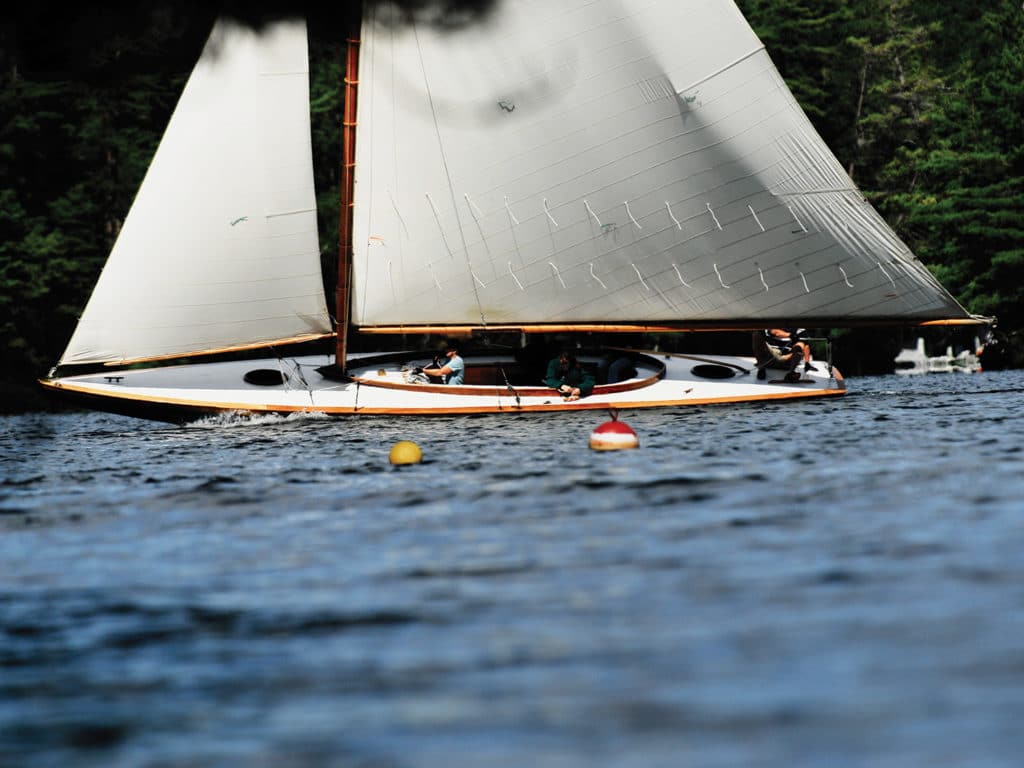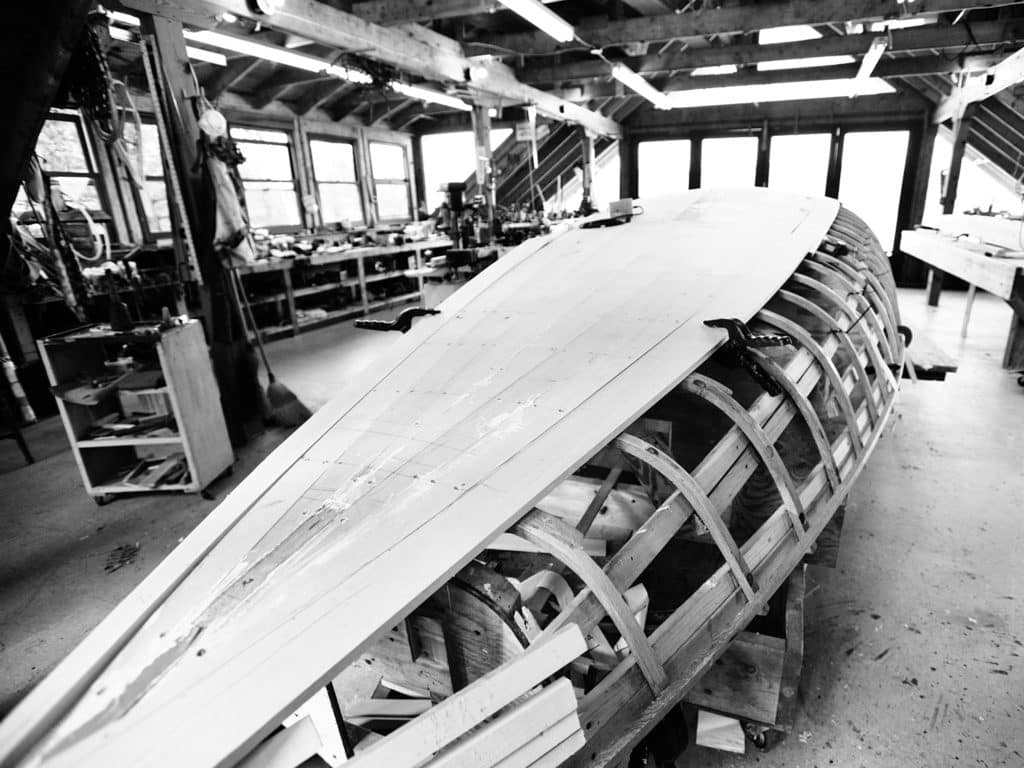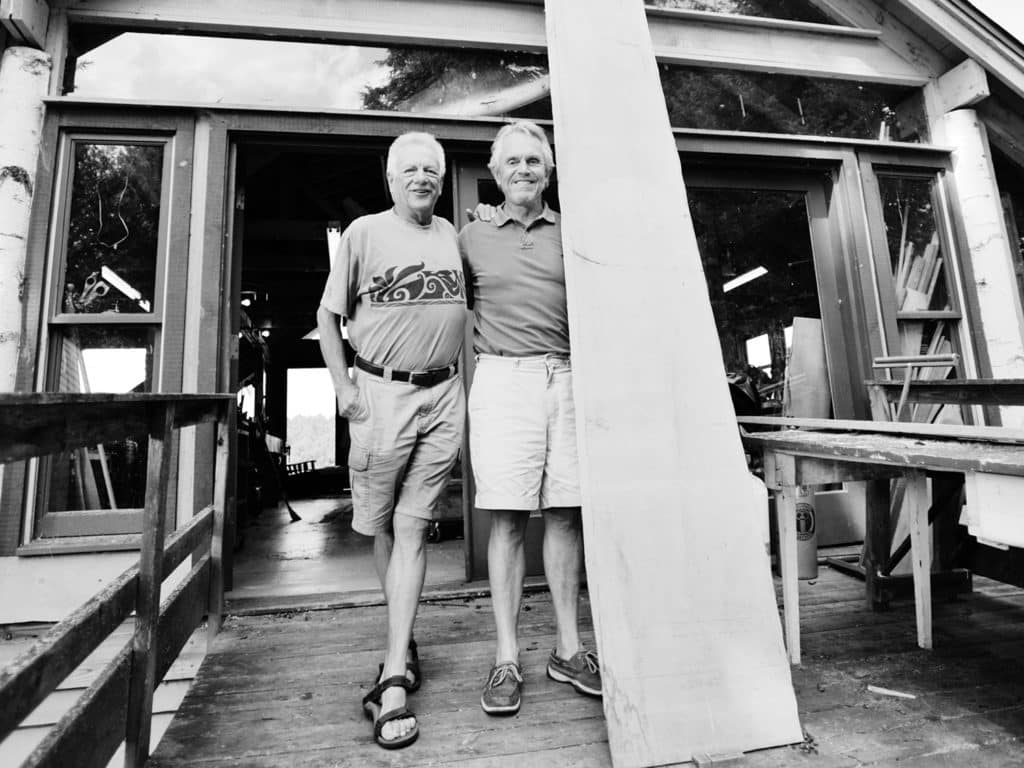
Upper St. Regis Lake, New York, is an off-the-beaten-path destination where members of St. Regis YC savor their anonymity. For more than 100 years, summer residents of this eclectic Adirondack enclave have combined a “great camp” lifestyle with a passion for a summer-long regatta. But the big news about this fleet in the forest is the ancient 32-foot one-design sloop that remains the club’s focal point.
My interest in Idem sloops grew out of a chance encounter at a Safety at Sea Seminar in Larchmont, New York. A seminar attendee approached me during a break and asked if I’d ever heard of an Idem sloop.
The sailboat and its name weren’t familiar, so I asked for further details. Ogden Reid introduced himself as a lifelong Idem sailor and summer resident of Upper St. Regis—no mention was made of his six-term tenure as a member of the U.S. House of Representatives or his role as a past publisher of the New York Herald Tribune. He did, however, share some captivating tales about the lake, the boats he raced and his family camp, “Wild Air.”
What really caught my attention, however, was the familiar ring of a serious competitor describing the uniqueness of his fleet. He extended an invitation to come and visit for a sail, and a few years later, while kayaking in the Adirondacks, I did finally spot a fleet of Idems in action.
Idem owner and skipper John Allen offered me a chance to get a closer look at a special fleet of sailboats and sailors in harmony with their local waters.
These agile scows fit their evergreen backdrop and the shifty mountain breezes that keep them animated. On the lake, tactics are made more by instinct than by calculation, and local knowledge is absolutely essential. All 10 of the gaff-rigged scows I witnessed seemed equally competitive.
Mainsail trimmers, perched on the aft deck, didn’t have much room to duck the overhanging boom during each tack or jibe. Tightly-woven Egyptian cotton sails were another authentic stamp of antiquity, and even the combination of a 600-pound centerboard and three or four crew in the cockpit—all crammed to windward—didn’t always keep the boats upright. The big mainsails didn’t make things any easier, and each puff arrived with a mast-thumping punch.

The next day was a rainy, windless washout, and the Adirondack Museum, built on the shore of picturesque Blue Mountain Lake, proved to be the right place to gather more information about the Idem. Woodworking and watercraft are ingrained in the heritage of this region, and the centerpiece of the Museum is the Reid family’s sloop, Water Witch. Its designer, Clinton Crane, a Harvard-educated engineer from Oyster Bay, New York, followed his sailing interest and became an amateur yacht designer, drawing winning sailboats for many of his friends. Later in his career, after a stint running his family’s mining business, he returned to his drawing board and added the 12-Meter sloop Gleam and the J Class Weetamoe to his portfolio.
The Idem was one of Crane’s first projects. Radical for its day, at 32 feet overall and 19 feet at the waterline, the gaff-rigged scow sloop with a non-overlapping, clubfoot boom, was designed in 1897 for the St. Regis YC. Members wanted a one-design that was fine-tuned for flat water and the normally light air conditions on St. Regis.
Flat sections, narrow beam, light-weight for the day—about 6,500 pounds—and 600-square-foot working sail area met their requirements. But even with a ballasted centerboard and crew on the rail, the sometimes gusty, shifty, atypical days of summer can up the ante; capsizes are familiar territory and still excite spectators.
Crane’s line drawings came with interesting construction plans that included two fore and aft wooden trusses used to add stiffness to a lightly built hull with extreme overhangs. The scantlings of these boats were never meant to win the test of time. And it’s likely the canoe- and guide-boat building skills and talents of local craftsmen and mainsail trimmers such as Jim Cameron, Nik Santagate and others are what have kept these treasures sailing, refit after refit.
The idea of a new boat in the fleet is guaranteed to raise eyebrows, but the Millennium Falcon had been carefully lofted and built as closely as possible to the lines of existing Idem sloops. Crane’s few, but informative, construction details were closely adhered to.
And amateur boat builder and Upper St. Regis Lake resident Nelson Crawford built the new Idem in his state-of-the-art, lakeside boat shop. The hull was framed with white oak and planked with Alaskan yellow cedar Crawford was able to acquire in lengths long enough to scribe full-length planks. Even his shop fit the aesthetics of the surrounding woodlands and great-camp architecture. But the panoramic view probably hampered productivity.
His shop looked like an amateur boatbuilder’s dream come true. A table saw and other key power tools surrounded the strong-back he used to anchor the transverse frames of the new hull, enabling a bottom-side-up approach to planking the hull. Use of modern polyurethane adhesive and epoxy caused some added consternation, but the fact that these materials were already being used on many of the Idem sloops that had undergone major refits quelled much of the controversy. While visiting Crawford, there was another new Idem under construction.

The big question revolves around why, not how, this one-design scow has so eloquently defied obsolescence? Part of the answer revolves around the tradition that has been shaped by a century of sailing the same boats. But there’s much more than old habits at play. Location and aesthetics are major factors as is the lake-locked lifestyle that insulates the population. There’s a remoteness to this corner of the Adirondack State Park that excludes many distractions, allowing a summer’s worth of regattas to take center stage.
Part of Upper St. Regis Lake folklore includes some freshwater scuttlebutt about the summer Buddy Melges showed up to put on a scow-sailing clinic and teach local Idem sailors a thing or two. When the classroom session was over and sailors started putting what they learned into practice, some say Melges and the Idem crew he was sailing with let the locals lead the fleet, while others still swear he had no other choice.
During my visit with Allen, at his Pulpit Rock summer camp, I couldn’t help but notice how inextricably linked boating and summer life have become in St. Regis. Boathouses usurp the role of garages and many of the covered slips accommodate elegantly restored mahogany runabouts. Allen had a couple of favorites and a vintage Chris Craft was his stand-in for a station wagon.
One day, we motored around the lake to get a look at the Idem fleet’s race course and I noted how challenging a shifty northerly must be. Tactical decision-making was obviously as important as boatspeed, and local knowledge must include how weather systems and the mountain range’s orographic effect conspire to aid or torment each crew.
Back at Pulpit Rock we chatted about how yacht clubs around the world often opt for a new one-design to rekindle enthusiasm, draw new members and get more of the old membership back on the water. I wondered how St. Regis had succeeded by doing just the opposite? Without hesitation, Allen cut to the chase. He pointed out that most yacht clubs lack what SRYC has to offer.
“Here we live on the shoreline of the racecourse, have a multigenerational linkage with our boats and families—amassing a scrapbook of memories that spans decades,” he says. “Weekdays are like lay days at a major racing event—a time when crews and neighbors mingle recounting the prior day’s action and who’s looking good on the water. As summer progresses, starts get better and the windward legs can become a game changer.
“Each regatta weekend helps shape lasting memories, and with children on the lake enjoying their junior sailing program and getting experience aboard bigger boats, it’s no surprise that many camps remain in families for generations, giving us a chance to nurture the old Idem fleet and all that goes along with such a sailing tradition.”
St. Regis Yacht Club’s 121st racing season ended on Labor Day 2018. In the last race, nine Idem sloops battled in fair weather with a good breeze.
Tom Conrad (I-29) and his crew had the day and the series sewn up. Second-, third- and fourth-place boats were only 1 point apart. After the annual Labor Day Tea—an event that incorporates the prize giving and signifies that another successful season has closed—each Idem is hauled, mast unstepped and deck covered for the winter.
Soon the lake is frozen solid, snow coats the forest, and plans for season number 122 are already well underway. A beautiful illustration of yachting history repeating itself.









